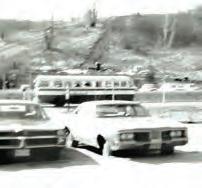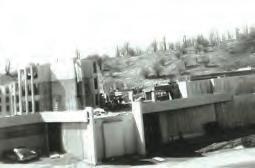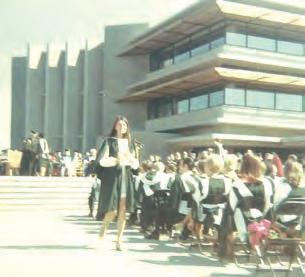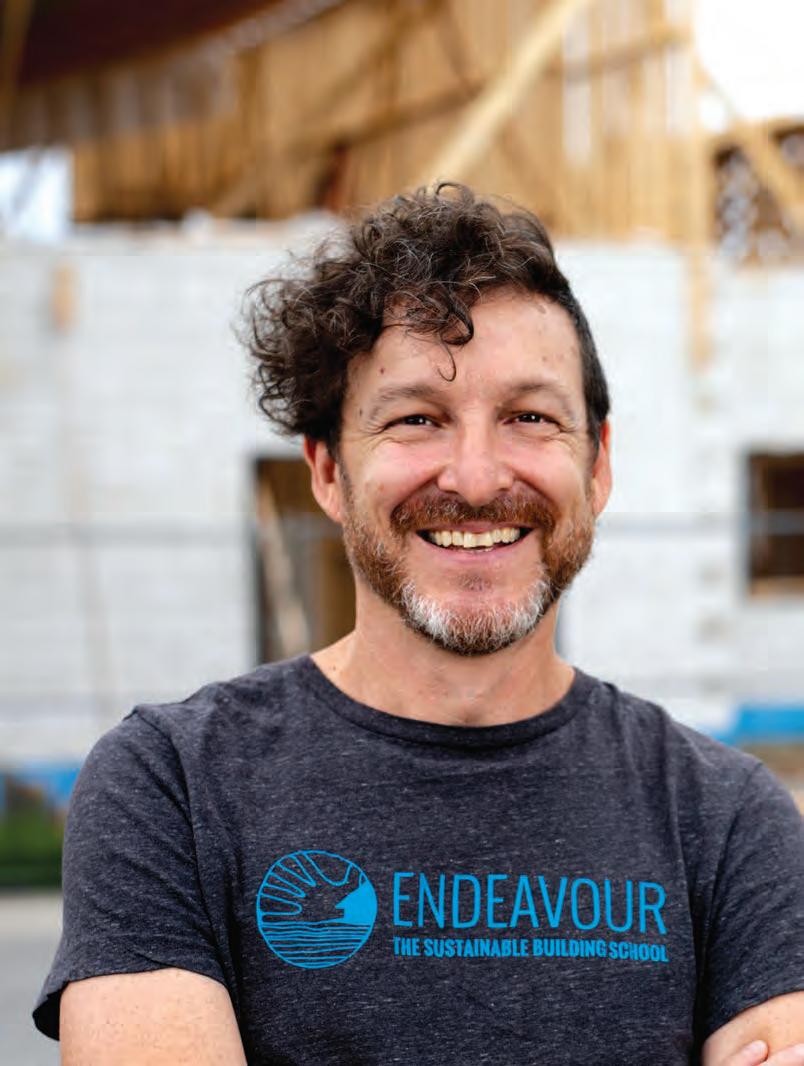

Little Feet. Big
after your family is not just about today’s new shoes, it’s about always.

life fully and enjoy every moment, confident
the future of those most important to you.
visit us at:
TRENT Magazine is published three times a year in June, October and March by the Trent University Alumni Association. Unsigned comments reflect the opinion of the editor only
Trent University Alumni Association
Alumni House, Champlain College
Trent University
Peterborough, Ontario, K9L 0G2 705.748.1573 or 1.800.267.5774, Fax: 705.748.1785 Email: alumni@trentu.ca

trentu.ca/alumni
EDITOR MANAGING EDITOR
Donald Fraser ’91
COPY EDITOR
Megan Ward
DESIGN
Beeline Design & Communications
CONTRIBUTORS
Michael Classens, Sylvia Dick, Donald Fraser ’91 Lee Hays ’91, Melissa Moroney Kathryn Verhulst-Rogers
EDITORIAL BOARD
Marilyn Burns ’00, Donald Fraser ’91, Lee Hays ’91, Melissa Moroney, Ian Proudfoot 73
PRINTING and BINDING Maracle Press, Oshawa
TUAA COUNCIL HONORARY PRESIDENT T.H.B. Symons
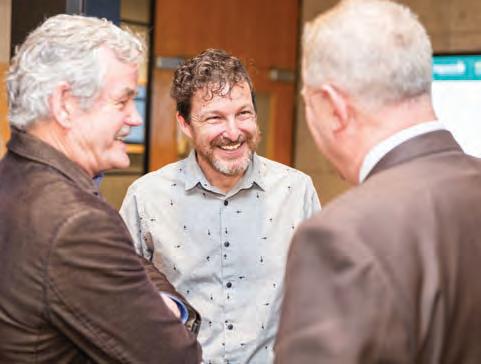
PRESIDENT Jess Grover ’02
VP CAMPUS COMMUNITIES
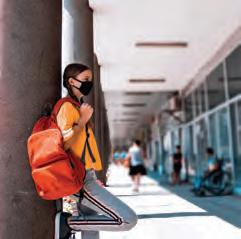
Karen McQuade Smith ’06
VP COUNCIL ORGANIZATION Steve Robertson ’93
VP COMMUNICATIONS & MEMBERSHIP Danen Oberon ’07
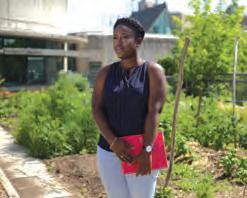
VP ENGAGEMENT AND PHILANTHROPY
Maile Loweth Reeves ’79
COUNCILLORS
Sonia Brandiferri ’10, Athena Flak ’99
Karen Foster ‘05, James Forrester ’14 Dorcas Mensah ’13, Ying Ying Tong ’14
CHAPTER
Maile Loweth Reeves ’79 (York Region) Caleb Smith ’93 (Niagara Region)
Lorraine Bennett ’72 (Vancouver)
David Wallbridge ’96 (Halifax/Dartmouth) Steve Cavan ’77 (Saskatoon)
Gordon Copp ’76 (British Isles) Patrick Lam ’86 (Hong Kong)
SENATE
Itwas an evening early this past April. Pandemic life was new.
Novel. It almost seemed like a short adventure. We’d be back to work soon, I reasoned at the time. Back to normal.
Clad only in my finest pair of boxer briefs, I was almost into the living room, an adult beverage for my sweetie in hand, when I suddenly remembered that the living room was now a virtual classroom, where my teacher wife was hosting office hours for her high school Mathematics of Data Management students.
“Man,” I thought aloud while skidding to a halt in the hallway. “Physical distancing is weird.”
Physical distancing is weird. The pandemic continues to be weird. And, while a new normal has settled in, it’s going to continue to be weird for a good while yet.
As much as COVID-19 has kept us apart, it’s also brought us together. And I am truly amazed at some of the stories from and about alumni who have responded to the pandemic by doing their best to keep their communities healthy and strong—physically, mentally, and emotionally. We’ve heard of alumni streaming fundraising concerts online, delivering food to those in need, and volunteering on the COVID front lines.
Speaking of the front lines, there have been countless numbers of alumni working in the healthcare sector—particularly graduates from the Trent/Fleming School of Nursing. And I want to offer some particular
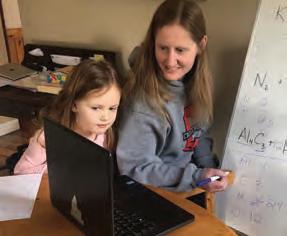
A TOAST TO OUR HEROES
recognition to them. One of my fondest memories of these pandemic times is interviewing nursing alumni, alongside Dr. Kirsten Woodend, dean of Nursing. By the end of the interview, the sense of pride and comradery was palpable. These were alumni who were both proud and thankful to be part of a community of graduates doing so much good in the world. It was, perhaps, one of the warmest interviews I’ve ever been a part of.
Another incredible moment came when I had the opportunity to interview a few parent/educator alumni from the Trent School of Education, Mitch Champagne and Rich McPherson, alongside the dean of the School, Dr. Cathy Bruce. Think helping your child with distance education is hard? Try leading 80-some-odd students through a brand new world of online learning, often at the strangest of hours (for high school kids) and then finding time to teach your own. The conversation I had with these alumni was eye opening—and I have both a teacher wife and a five-year-old daughter. It was also, as with the nursing discussion, one of the most heartwarming interviews I’ve ever participated in. I’m honoured to share excerpts of both the nursing and educator interviews in this edition.
Speaking of heroes, some of the biggest ones never even left their house during the first months of the pandemic. It didn’t take long before parents realized that their lives were going to be flipped upside down— and that between countless Zoom meetings, tag-team shifts where childcare and working from home were precariously balanced, and taking the lead in educating their children, moms and dads everywhere were pushed to their limits.
I’m also honoured to congratulate all of the heroes out there. And, if you’re reading this, I’m including you. It has been tough. And it has been weird. But we’ve persevered. Which deserves a special toast to us all. And, for this one, I’ll even put my pants on.
Donald Fraser ’91 donaldgfraser@trentu.ca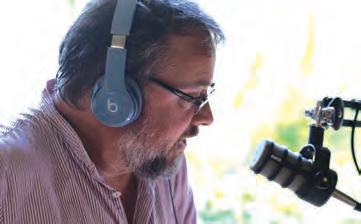
A STEP FORWARD
IfI were to add anything to Lao-Tzu’s well-known aphorism, “A journey of a thousand miles begins with a single step,” it would be the word forward. Faced with the uncertainties of the COVID-19 pandemic—as every university, business, group and person has been these past many months—we decided early on that taking careful yet decisive steps forward would define Trent University’s response.
Hence the Trent Forward plan that has guided us shortly after we took our summer term online and began the complex task of recreating events, like convocation, virtually; gradually returning researchers to their labs; and planning for a very different fall and winter term.
As usual, our alumni have enthusiastically joined our students, faculty and staff in playing a part in the solutions. Alumni like Stephen Stohn ’66, who has led a compelling series of Trent Talks addressing a raft of pandemic-related issues and other topical concerns with faculty experts. I wish to thank Stephen for hosting these talks with the trademark warmth, insight and sensitivity he adds to all discussions. He brings genuine curiosity and a spirit of discovery to every conversation—proving that Trent’s interactive learning environment really can translate across a virtual platform.
Alumni have responded to the call to support the Student Relief Fund for domestic and international students alike. Still others have stepped up to rally behind the new RELI program (Remote Learning Initiative), an effort that has raised over $250,000 to provide 500 Chromebook computers to students most in need. The program has

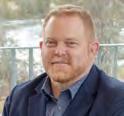



exceeded its fundraising goal and hundreds of students are able to stay in school.
This issue of TRENT Magazine another step forward, as it includes pieces related to the pandemic— like the fascinating panel discussion on nursing in the pandemic—while reminding us that there are other issues that demand our attention, such as the important dialogue you will read about on race relations. In addition, both the announcement about the Trent Enterprise Centre at Cleantech Commons and profile on Jill Bishop’s ’98 work in regenerative agriculture reinforce, once again, Trent’s prowess in advancing a prosperous and environmentally-sustainable future.
Trent’s campuses and colleges have enthusiastically embraced the mask culture during the pandemic with vibrant expressions of mascots and colours

As we navigate the uncertainties of 2020 from a distance, together, I hope this issue of TRENT Magazine finds you well and that its content inspires your belief that every step forward brings us closer to the promise of a better tomorrow. Thank you for your readership, engagement and support.
Dr. Leo Groarke, Ph.D.,President & Vice-Chancellor
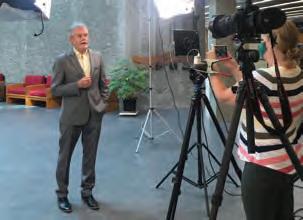
WHAT’S NEW AT TRENT UNIVERSITY
Trent Ranked Amongst World’s Best
Trent’s exceptional learning environment and academic performance has earned the University a spot in the top 6.2% of universities worldwide. In the 2020/21 Centre for World University Rankings (CWUR) Trent is holding steady at number 32 out of 96 Canadian universities, while placing 1,237 out of over 20,000 global institutions, up nine places from last year’s 1,248 place ranking.
“We are proud to see Trent recognized as a notable institution for both world-class research and exceptional learning experiences,” said Dr. Leo Groarke, president and vice-chancellor of Trent University.
Trent Nursing Leads with International Accreditation
In a first for a Canadian university, the Trent Fleming School of Nursing (TFSON) Simulation Hub has achieved full international accreditation. The Society of Simulation in Healthcare accredited the facility based on core standards of mission and governance, program management, resource management, human resources, program improvement, integrity and expanding the field.
“Our internationally recognized accredited simulation program speaks to our expertise, professionalism, and commitment to the highest standards in teaching and learning,” says Meaghen Regts, Hub coordinator.
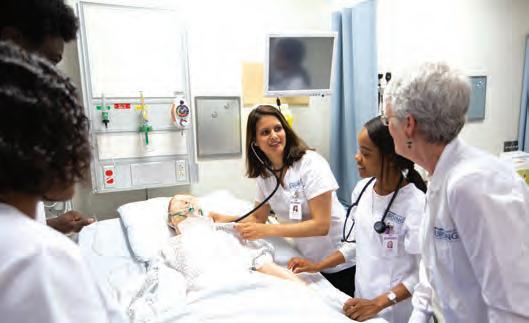
A Decade on Top: Trent is Ontario’s #1 Undergraduate University for 10 Consecutive Years
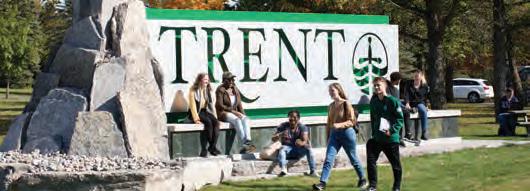
Two Innovative New Degree Programs in Kinesiology, Financial Analytics

This fall, Trent added two new B.Sc. degree programs—Kinesiology and Financial Analytics—to its growing roster of innovative programs.
The four-year Kinesiology degree offers placement opportunities allowing students to gain critical career experience working with everyone from Olympic hopefuls to senior citizens.
The one-of-a-kind Financial Analytics degree combines many aspects of finance including mathematics, statistics, economics, business and computing—an advantage that no other program offers.
For the tenth consecutive year, Trent University has ranked the number one undergraduate university in Ontario, in addition to being number one in all of Canada for scholarships for 20 years in a row as well as a provincial leader in several important student support categories—all highlights of the 2021 Maclean’s University Rankings
“Each year, these rankings help to showcase Trent as the number one primarily undergraduate university in Ontario,” says Trent University president and vicechancellor Dr. Leo Groarke. “Other notable results this year are Trent’s provincial and national leadership in areas that matter most to students: scholarships, support services, experiential learning, and student satisfaction.”
In national reputational rankings, Trent was named the number one undergraduate university in Ontario for highest overall quality, and the number two undergraduate university in Ontario for producing leaders of tomorrow. Trent also now holds the number one spot for promoting Indigenous visibility across all undergraduate universities in Canada.
Federal Boost for Cleantech Commons
A key component of Cleantech Commons has received a $4.8-milllion boost from the federal government. The Federal Economic Development Agency for Southern Ontario announced the funding to support infrastructure in the Trent Enterprise Centre (TEC)—a key building in the on-campus research park that will offer labs, tech assessment, office space, demonstration zones and scaleup facilities specifically designed to support the commercialization of clean technology.
Trent Innovation Preps First-Year Chemistry Students Across Globe
Historic Moment: Trent Signs MOU in Virtual Ceremony
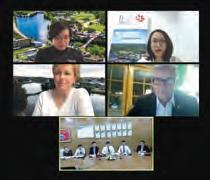
In a historic first and a sign of the times, Trent University has used Zoom to sign a memorandum of understanding (MOU). Trent and International University-Vietnam National University (IU) used a virtual ceremony on June 3 to sign the MOU to explore developing academic exchange and transfer programs for IU students to study at Trent. The virtual ceremony was held in part due to restrictions on international travel brought about by COVID-19.
Thanks to a fully accessible online resource created by Trent University, Chemistry students everywhere can be better prepared for first-year. Chemistry professor Dr. Andrew Vreugdenhil and graduate student Kelly Wright created the free public digital resource ‘Be Prepared! Everything You Should Know for FirstYear Chemistry.’ It’s available as an open educational resource through
eCampusOntario—a nonprofit that aims to increase access to online-learning resources for postsecondary students.
With the pandemic creating some upheaval for Grade 11 and 12 students this year, Professor Vreugdenhil says this resource is more critical than ever to ensure no Chemistry student feels left behind.
Land Purchase Cements Trent’s Long-Term Growth in GTA
After the Board of Governors approved purchasing 1.9 acres of land next to the Trent Durham campus for future growth, Trent President Leo Groarke said resulting future expansion will “alleviate some immediate needs on the Durham campus and cement the University’s long-term plans for strategic program development and growth in the Greater Toronto Area.”
With short and long-term use of the properties to be determined, the land could help address future space needs for faculty and students and be an investment property for the University.

SPOTLIGHT ON RESEARCH
As home to many of the world’s leading researchers, Trent University has countless stories to tell when it comes to research success. Through our outstanding researchers, world-class facilities, and prestigious schools of study, Trent is a place where ideas and creativity connect and intersect with industry, non-profits, communities and real-world solutions. Read more about some of the top faculty, student, and alumni researchers who are making headlines.
RESEARCH SPOTLIGHT
The spectacular and intricate colour patterns on the wings of butterflies are one of the most noted examples of beauty in the natural world. With over 22,000 different butterflies, yet no two demonstrating the same patterns, Dr. Craig Brunetti, leading researcher and dean of the School of Graduate Studies, investigates the role certain genes play in these unique and striking patterns.

STUDENT RESEARCH SPOTLIGHT
Novel Research Examines
Disease

A lifelong fascination with the intricate workings of the human brain has led Joesphine Esposto, M.Sc. candidate in the Environmental and Life Sciences program, to explore the puzzling questions surrounding its functions.
With her current research at Trent, Ms. Esposto is beginning to study and critically analyze the major pathological protein causing Amyotrophic Lateral Sclerosis (ALS)—also known as Lou Gehrig’s disease—and other neurodegenerative diseases such as TDP-43.

“Not much is known about the research on this protein, and only a few institutions across the globe are looking into it,” says Ms. Esposto. “Because of this, I will be experimenting with
While Professor Brunetti’s research primarily focuses on viruses and immunology, his interest in butterfly wing patterning is a long-standing project. Thanks to advances in technology, the use of CRISPR/Cas9 deletion techniques allowed for further insight into key gene function and interaction, particularly that of the Spalt gene in wing margin colour patterning.
a protein that is unique to the Martic Lab at Trent.” Ms. Esposto is hopeful that the published work will lead to viable treatment options to help people suffering from ALS. “At the very least, it will help shine more light on how the disease progresses.”
ALUMNI RESEARCH SPOTLIGHT
From Self-Dissolving Dressings to Human Tissue Growth

ALUMNI
#TRENTURESEARCH HIGHLIGHTS
A receding gum line can be a real pain. As gums recede the roots of the teeth may be exposed. Periodontists treat the condition by grafting tissue from the roof of a patient’s mouth, which can be painful.

To inform the societal response to COVID-19 and future infectious diseases, Trent has mobilized funding to invest in nine research projects that will contribute to our holistic understanding of the pandemic and how to mitigate its impact. Here’s a sample of research projects currently underway.
Under the guidance of Chemistry professor Dr. Andrew Vreugdenhill, Trent alumnus Brian Webb ’20, B.Sc., Biomedical Science, developed a selfdissolving wound dressing with anti-bacterial properties derived from plant extracts.
Mr. Webb, now pursuing his Master of Applied Sciences, is building on his innovative undergraduate thesis, as he begins to work on a technique that uses human stem cells to grow dense three-dimensional tissues in the laboratory. “This way you can get blood and nutrients going into the scaffold as soon as possible,” explains Mr. Webb. “You will be implanting something that already has all of the vasculature.”
DR. CATHY BRUCE APPOINTED ACTING VICEPRESIDENT RESEARCH AND INNOVATION

NSERC Alliance Grant to Focus on Rapid SARS-C0V-2 Detection Dr. Sanela Martic, an assistant professor of Forensic Science at Trent and cross-appointed to the Environmental and Life Sciences graduate program, is working to develop a benchtop testing method that can rapidly detect the SARS-CoV-2 virus. The Natural Sciences and Engineering Research Council (NSERC) has awarded Professor Martic an Alliance Grant to collaborate with an Ontario-based biotechnology company to study optical sensors as a rapid and cost-effective alternative for SARS-CoV-2 detection that may be used by individuals without specialized health care training.
Exploration of Vaccine Hesitancy in a COVID-19 World Dr. Kelly McGuire, associate professor of English and Gender & Women’s Studies and chair of Gender and Women’s Studies, is working to inform the societal response to COVID-19 and potential future infectious disease outbreaks. Professor McGuire will focus her research on exploring the specific dynamics of vaccine hesitancy as well as concerns relating to social justice and gender—areas that public-health campaigns have been criticized for not sufficiently addressing in the past.
The Impact of Physical Distancing on Older Volunteers

Dr. Elizabeth McCrillis, director of the Trent Centre for Aging and Society, and a team of researchers at Trent are studying how the elderly and older volunteers in rural communities are coping with the impacts of physical distancing during the COVID-19 pandemic. While COVID-19 is particularly dangerous to the physical health of older members of the population, the social-distancing measures meant to protect them can be just as damaging. The study seeks to gain an understanding of the experiences of rural older adult volunteers as the pandemic has significantly limited the ability of volunteers to support older community members.
In August, Professor Bruce was appointed to this new role at Trent, bringing 17 years of proven leadership and dedication to collaborative research.
Follow @TrentUniversity #TrentUResearch on Twitter to read more research highlights and stories, and share your own #TrentU research stories.

THANK YOU JACKIE MULDOON
TRENT UNIVERSITY CELEBRATES THE CAREER OF PROVOST AND VICE-PRESIDENT ACADEMIC
DR. JACKIE MULDOON
A Trent employee of nearly four decades, Professor Muldoon served in a variety of roles, from senior tutor and department chair to dean of Education and provost
Oneof the University’s longeststanding employees of 37 years, Dr. Jackie Muldoon is being honoured by Trent for her numerous accomplishments and contributions, including a highly successful five-year term as provost and vice-president Academic.
Professor Muldoon served the University with distinction in the role of provost and vice-president Academic from 2015 to 2020. During her term, Prof. Muldoon played a leading role in the development of innovative programming, which promoted increased enrolment, including new undergraduate degrees and new professional master’s programs, as well as establishing key transfer agreements with partner institutions. As a champion for personal development and ongoing education, Prof. Muldoon grew and expanded experiential and work-integrated learning opportunities for students at Trent University, and elevated support for faculty through the Centre for Teaching & Learning. A true visionary, she continued to strengthen and guide efforts to maintain and enhance Trent’s reputation for excellence in teaching, a personalized approach to education, access to faculty and its world-class reputation for research and innovation.
“I feel very lucky to have worked with Dr. Muldoon, and lucky to be able to celebrate her career and her accomplishments,” said Dr. Leo Groarke, president and vice-chancellor of Trent University. “She is a giant in the history of Trent—having held a remarkable series of leadership positions over the course of a long career. We will miss her extraordinary insight and her deep understanding.
On behalf of the University, I want to warmly thank her for her leadership in so many areas, and wish her equal success in her future endeavours.”
Beginning her career at Trent in 1983 as a professor in the Department of Economics, Prof. Muldoon served as head of the Business Administration program from 1998 to 2007 and was appointed director of the School of Education and Professional Learning in 2007, before becoming the first dean of the School in 2010. As dean, Prof. Muldoon successfully guided the growth and development of the School of Education into a leading institution for the study of education in Canada.
At Trent, Prof. Muldoon also served as senior tutor and member of the faculty association executive. She also travelled internationally to forge important partnerships and support student recruitment.
“Jackie Muldoon was an integral part of the Trent family for so many alumni,” says Trent University Alumni Association president Jess Grover ’02. “As a professor, a dean, and finally provost, she always found time for alumni voices. Whenever she traveled, she would reach out to alumni and take every opportunity to reconnect with all friends of the University. Prof. Muldoon’s exceptional dedication will continue to be remembered for years to come”
Throughout her career, Prof. Muldoon has been celebrated as an advocate for human rights and Indigenous reconciliation. As provost, she sponsored the Provost Lecture Series in Indigenous Studies on Truth and Reconciliation, was instrumental in the development of the Indigenous B.Ed. program, served as chair of the Special Committee on Indigenous Education and introduced the University-wide commitment to Indigenous education for all undergraduate students.
Prof. Muldoon holds a B.Sc. in Mathematics & Economics from Brock University, an M.A. in Economics from the University of Guelph and a Ph.D. from McMaster University in Economics. An established researcher, Prof. Muldoon focused on health economics, consumer choice and income inequality in the accessibility of health care.
THE TRENT UNIVERSITY COMMUNITY: TOGETHER APART
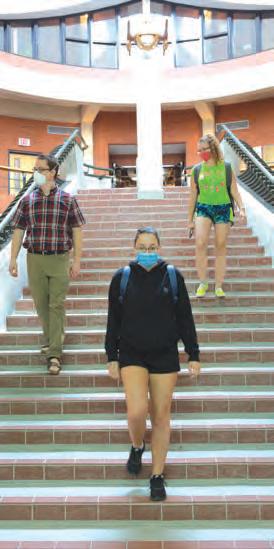 A message from Lee Hays ’91 Director, Alumni Engagement & Services
A message from Lee Hays ’91 Director, Alumni Engagement & Services
Greetings,Trent community. I hope all is well with you and your families. A year ago, no one could have predicted the year of change ahead. When the pandemic reached our campus communities in March, we faced the unprecedented, as we all tried to grasp the reality of moving 10,000 students and over 1,000 staff and faculty to remote operations. But within mere days, hundreds of courses were adapted so that students could complete the term remotely, and teams across the University campuses began the process of adapting their work to the new environment.
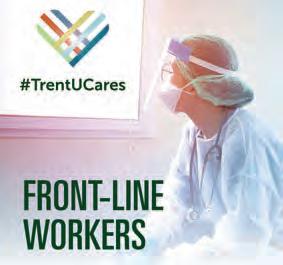
Alumni and other members of the Trent community showed just how much #TrentUCares by creating the Student Rapid Relief Fund, raising more than $130,000 to help students who were impacted financially to stay in school. Not long after, generous donors again stepped up to fund 500 Chromebooks so that students without technology could continue their education this fall.
Not being able to hold live convocation ceremonies resulted in an innovative and exciting online celebration, Grad from Your Pad, which enabled 2,000 graduating students and their friends and families to mark the end of their Trent degrees in a fun and memorable way.
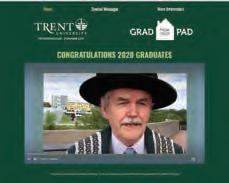
Trent Talks, formerly an event that took place in chapters across Canada, quickly morphed into a web series hosted by Chancellor Stephen Stohn ’66. More than 30,000 viewers listened to Trent’s faculty experts speak on timely issues, such as economic recovery, understanding COVID-19, global impacts of the pandemic, racism, and the great mask debate.
Life after Trent Club moved online, providing live online career and networking tips from experienced alumni to our more recent graduates.
And who could have imagined that Homecoming would become a virtual event? For the first time in almost 50 years, alumni from around the world participated in a weeklong series of reunion events. While nothing tops standing on the Faryon Bridge, cheering on the rowers in the shadows of the autumn-blazed drumlin, it was a meaningful way for alumni to reconnect with each other in cyberspace.
With so much going on in 2020, I want to extend a sincere thank you to all of the volunteers, donors, and ambassadors for all that you do. The encouragement and involvement of alumni and friends helps Trent succeed in its mission in preparing students to make significant contributions to an increasingly complex world.
Stay healthy and be kind to each other.
In 1998, Chris Magwood ’85 built a home for his family.
What he didn’t realize at the time was that he was also building himself a career. Armed with an English Literature degree, he hoped that this custom home, north of Madoc, would be a place where he could make a living for himself as a writer.
But while he continued his freelance work, it was his house that was really garnering attention. Mr. Magwood’s home, you see, was the first straw bale house in Ontario. And, as he would soon find out, it was kind of a big deal.
“While it wasn’t my area of study, during my time at Trent, my environmental awareness grew,” he recalls. “So, when my partner, Julie, and I decided to build a home, we wanted it to be as environmentally friendly as possible.”
And people noticed.
BUILDING MOMENTUM
Alumnus Chris Magwood is Helping Lead the Way in a Sustainable Building Revolution
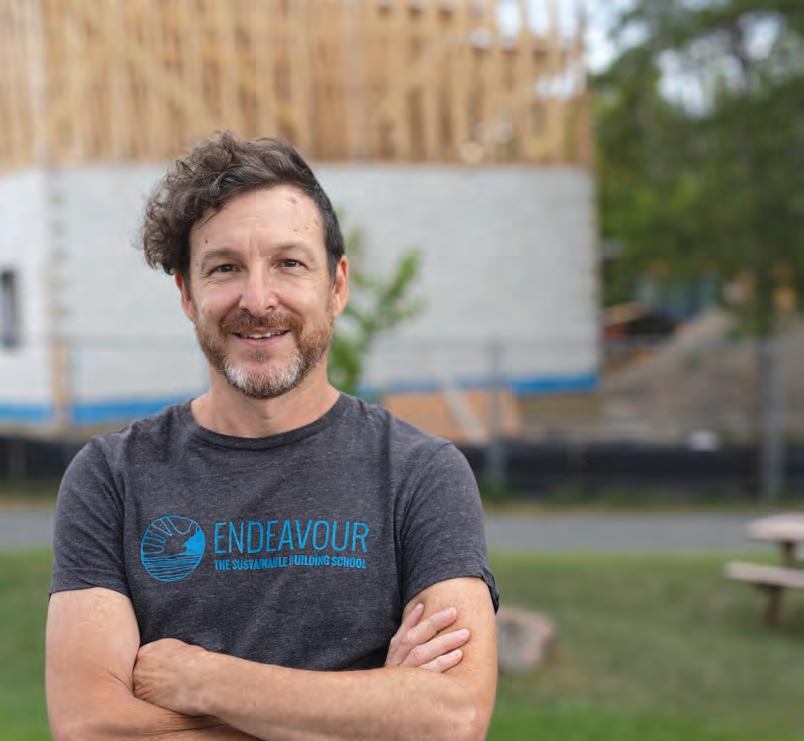
“That first construction project was supposed to be it,” he confesses. “I was building the house that I was going to live in and do my writing in. But what happened was that people found out about this straw bale house and got excited about it. And that led to people asking for me to help with their houses. Then someone asked me to do a workshop…. Within two years, it became a full-time thing. And it’s been like that ever since.”
In the years following, Mr. Magwood grew from pioneer to leader in the green building movement. Currently leading one of the companies working on the new Forensics Crime Scene Facility at Trent, his knowledge and experience is sought after by businesses and institutions across North America.
“I’m sometimes shocked about who I’m in the room with now, and who’s interested, and who’s talking. It’s really encouraging to see these big companies recognizing the importance of sustainable building and putting their money where their mouths are.”
Not bad for a guy who just wanted to build his family a home.
From Builder to Author to Educator
By 1999, Mr. Magwood was building full time alongside friends and business partners Pete Mack and Tina Therrien. They spent the next seven years as Camel’s Back Construction, working on dozens of straw bale buildings and learning how to make natural building materials and renewable energy systems practical and efficient.
Three or four years after that, he found the intersection between his early love as a writer and his current passion for sustainable construction. In 2000, he co-authored the book Straw Bale Building with Mr. Mack and Ms. Therrien. It was the first of seven books he’s written to date. Along the way, he’s published magazine articles, contributed to other books and acted as editor of The Last Straw Journal
By 2005, he decided to take the educational aspects of his work to a more organized platform, proposing a curriculum for a Sustainable Building Design and Construction certificate program to Fleming College. He held the position of lead instructor until 2011.
In 2012, he helped found The Endeavour Centre, a notfor-profit sustainable building school that offers both full time programs and workshops on natural and sustainable building materials and strategies, as well as renewable energy and efficiency techniques and technologies. Endeavour teaches in a hands-on manner that sees students working on remarkable new buildings for individuals, businesses and institutions. The Forensics Crime Scene Facility is the second major building they’ve worked on at Trent, alongside the Camp Kawartha Environment Centre.
And he’s kept writing.
Chris Magwood and Trent President Leo Groarke discuss building materials for the new Forensics Crime Scene Facility
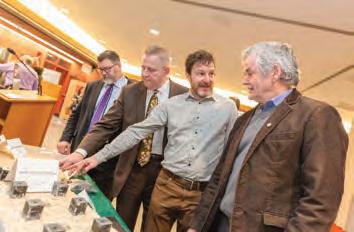
“I’ve just begun book number eight,” he says. Beyond Zero is about the potential for buildings to be carbon “drawdowns,” or repositories for atmospheric carbon. His other titles include Essential Sustainable Home Design and Making Better Buildings
Building a Better Future
While Endeavour takes on many types of clients, Mr. Magwood sees institutions as an integral part of his work.
“We do try to work with institutions because you can impact more people,” he explains. “We really try to find public projects.”
In this way, his buildings become educational, not just to his student builders, but to the communities they are building in. “One of the fear factors people have about new materials and technologies is whether or not they will work, or whether or not they will last. Then you see these buildings when they’re 10 years old. The 4Cs Food Bank and Lily Anne Thrift Store in Haliburton was 2005, that’s 15 years old now. The RD Lawrence Place museum in Minden is 12 years old. And there are no problems with these buildings. So that helps put people at ease. And it normalizes it too. When it comes to a project, at first it will be seen as the weird building; then it just becomes ‘the building.’ It helps make this architecture and these practices less scary and more normal.”
While many clients know that they want to build sustainably, they don’t necessarily have a firm grasp of what that might mean. Endeavour (and Mr. Magwood) specialize in helping clients understand what exactly it is they’re hoping to achieve.
“There will be a notion that they want a ‘green’ building, and we’ve parsed out a way to figure out what that means for that person or that group. Big on the list for Trent University’s Forensic Crime Scene Facility is the carbon footprint, for others it might be the indoor environmental quality and making sure there are no harmful chemicals involved; or the physical footprint on the site and
minimizing that; or it might be energy performance or getting all your materials from the local economy. The needs show themselves in different ways. In this case, the carbon footprint is relatively simple. But, then, you have a building like the Camp Kawartha Environment Centre, where, as a means of showcasing the building as an educational model for sustainability, they were ticking the boxes for virtually every criterion. So that building turns out very different than if you are looking at one or two criteria.”
The Tipping Point
Things have come a long way in sustainable building since Mr. Magwood built that first straw bale home. What was then novel has become mainstream.


“I feel like we’ve hit the tipping point on awareness, but that we’re waiting for that to turn into action,” he notes. “We no longer spend any time arm-twisting people into thinking that sustainable building is important, that the carbon impact is important, that the indoor environment is important. Everyone is on side with that. The next step, now that you have everyone nodding along, is how to get people to invest. But I do think that is changing more rapidly now. I think the climate crisis is the driver of that. I can’t believe the leaps that are happening in terms of people’s awareness of the issue, the understanding of a building’s impact on the issue, and a real desire to address it.”
As the technology becomes more accepted by businesses and institutions, he looks to places like Trent for leadership in implementing it. “It’s leading institutions that set the bar, and everyone else comes along and tries to reach for it.”
For Mr. Magwood, Trent is remarkable for several reasons. “The thing about this institution is that they give people a chance. And because of the connections you make and the faculty understanding of the students, there’s an understanding that it’s not always the A+ students who do the cool stuff. When some people don’t excel academically, it’s not because they don’t have the ability, it’s because they’re busy doing other things.”
His undergraduate work at Trent showcases this. “When I was first at Trent, for instance, I was running this literary magazine. I was less invested in my courses than I was in the magazine, but, man, I was learning so much running that magazine. It was amazing. So, I ended up with a 72% average, which doesn’t look great on a transcript, but was absolutely integral for my development. It showed me that I could do things like start a business from scratch. Or that I could make all these contacts. It built me up as a person in a way that, if I had just done my studies, I would have missed out on.”
Being able to come back and do his master’s degree was a huge stepping stone for him. Technically not qualified for entry into the program, Trent—and Professor Stephen Hill—took a chance on him.
“I was proposing to Stephen something for which there was almost no academic literature to back it up. Especially when I started. When I put together a proposal, they asked me to put together a bibliography of works I would cite. And there
were maybe four articles at the time. When I finished my master’s, I re-did the same Google Scholar search that I did five years before and there were literally thousands of articles. But they went for it. And that’s incredible. I ended up being at the leading edge because Trent said, ‘you can do that here.’”
His work, on quantifying the carbon storage potential of building materials, has been integral to the growth of sustainable building practices, particularly carbon sequestration.
And people have definitely taken note.
“I’m now consulting with big tech firms in California who want to make their data centres carbon storing. And these are 500,000 square foot buildings that they put up 80 of a year.”
1 Zero House: Designed by students and faculty of the Architectural Science program at Ryerson University, Endeavour undertook the transformation of the design into a fully modular, prefabricated building that would be zero net energy, zero carbon footprint, zero toxins and zero construction waste.
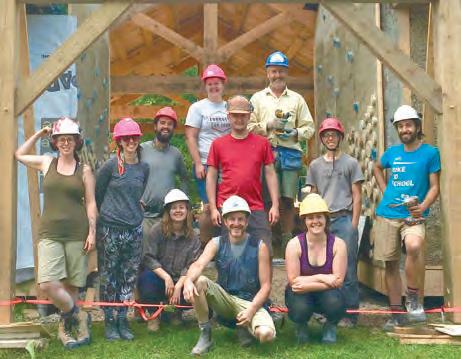
2 Canada’s Greenest Home was designed with the highest environmental standards possible and built to be sold on the open market to deliver “deep green” performance to the conventional housing market.
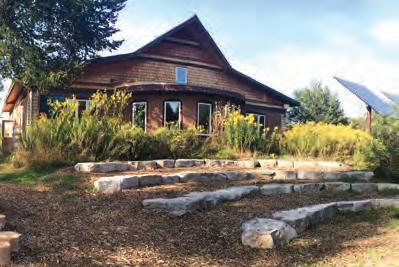
3 A typical Endeavour Centre student work crew.
4 The Camp Kawartha Environment Centre.
5 An Endeavour Centre renovation: transforming an old concrete garage into a healthy, zero carbon residence.

While Mr. Magwood’s career arc has surprised even him, it also seems natural. After all, he’s a builder. And that’s what he continues to do. Building facilities. Building momentum. And building a base of academic knowledge that didn’t exist before.
“I couldn’t have chosen a more interesting and impactful career path. Although, even now, I’m not sure that I chose it. The reach is now way beyond where I thought it would be.”
For more information, please visit endeavourcentre.org
NEW FORENSICS CRIME SCENE FACILITY
An Environmental and Academic First for Canada
Abrandnew Forensics Crime Scene Facility at Trent University will set new academic and environmental standards all at once, as a first-of-its-kind professional forensics training building constructed on a Canadian university campus— and with a goal to be Canada’s first zero-carbon building certified by the International Living Future Institute.
With the new building, the University will combine its renowned forensics leadership with its reputation as one of Canada’s top environmental teaching and research universities.

“The new Forensics Crime Scene Facility will be sector-leading academically and nation-leading environmentally,” says Dr. Leo Groarke, president and vicechancellor of Trent University. “This teaching-focused, environmentallyrestorative building is being designed by an alumnus of Trent, a story that reflects our institution’s core values and the long-term impact of a Trent education. We are very proud that this new facility will enhance the calibre of learning for our Forensics students while giving back to the environment.”
The new 4,100-square-foot building is a forward-thinking facility that will pioneer approaches to training students, and current practitioners, in forensic science methodology. Building upon the learnings from Trent’s 10-yearold Crime Scene House, the new facility will unite spaces for staging crime scenes, facilities for analyzing evidence and exhibits, as well as a classroom for reviewing and evaluating student performance.
Sector-Leading Academic Highlights:
• Large modular space: controlledenvironment and moveable walls to stage up to eight crime scenes
• Cameras: installed in crime scene spaces to record students’ analysis and allow instructor feedback on strengths and areas for improvement
• An adjacent, on-site lab space: modern equipment to process and analyze evidence and minimize cross-contamination in transport
• Garage lab: for vehicle analysis as the majority of crimes have a vehicle component
• Outdoor staging space: to train in evidence collection from different substrates (e.g., mud, gravel, sand)
• Mentorship: Opportunities for students to interact with professional practitioners
“Forensics is an applied science that draws on principles from many different disciplines, so we know how important hands-on crime scene investigations are for our students,” says Dr. Christopher Kyle, professor of Forensic Science at Trent. “This facility will enhance the learning experiences of our students, enabling them to develop and refine their technical skills and strengthen their critical thinking skills to become not only experts, but leaders in this field.”
In addition to the educational benefits this building will bring to Trent students, the Forensics Crime Scene Facility aims to be the first Zero-Carbon Certification in Canada, certified by the International Living Future Institute. It will be made of materials with carbon-storing properties and powered primarily by
Next Level Crime Scene
Space
Next
renewable energy. The new building will be located on the core campus beside Otonabee College just down the hill from East Bank Drive.
Sustainability Features:
• Aiming to be First Zero-Carbon certification in Canada by the International Living Future Institute
• Solar-powered roof panels to heat, cool and power the facility to achieve Net Zero energy
• Canadian carbon-storing materials:
• Hemp blocks from Albertan company Just Biofibre used to make the exterior structure
• Hemp batt insulation made in Quebec by Nature Fibres to be used for internal structure of the building
• Cellulose roof insulation made here in Ontario
• Charred wood siding from locally harvested wood
• Glavel under-floor insulation

Trent is working with a handful of partners on the project who will pioneer sustainable building practices in Canada. Trent is working with:
• Endeavour Centre: Chris Magwood ’85 is a director at the Endeavour Centre, and a two-time Trent alumnus who recently completed his Master of Sustainability Studies at Trent where his research revealed the carbon footprint of common construction practices and materials and identified sustainable alternatives.
• Christopher Z. Tworkowski, Architect
• Zon Engineering Inc., Mechanical, Solar, Net Zero
• Building Alternatives Inc., Structural
• Berthelot Engineering Ltd., Electrical
“It’s really exciting that a large institution like Trent University not only sees the value in constructing a building with the highest environmental standards, but is willing to try something that has
never been done before in Canada,” says Chris Magwood, Trent alumnus and director at the Endeavor Centre. “Trent’s facility will be the first to use hemp blocks and Glavel in Ontario and will be the first to use hemp batts in a non-residential setting.”
The project was made possible by the legacy gift from former Board of Governors chair, the late Jalynn Bennett. In 2018, the Jalynn H. Bennett Foundation donated a substantial gift towards the project, one of the largest legacy gifts in the University’s history. The new Forensics Crime Scene Facility is part of the Jalynn H. Bennett Trent Lands Enhancement Project, which funds projects that will enhance Trent’s natural setting,

academic excellence, increase engagement with the local and First Nations communities, and enrich the student experience.

Growing Change with Regenerative Food Systems

“[A]ny actual movement towards regenerative systems will still have to be based on a shift to health criteria and on a fundamental respect for biodiversity and cultural diversity as the sources of life and social viability.” (Dahlberg, 1994, 176)
MICHAEL CLASSENSIdeas have a way of (re)emerging when they’re most needed. As the world braces against the roil of ecological collapse, climate change, a global pandemic, deepening inequality, and alarming socio-political volatility, regenerative agriculture is perhaps one of those ideas.
But what is regenerative agriculture? The truth is, there is no universally agreed upon
definition, and this multivalence is both tantalizing and frustrating. Google’s N-Gram—a measure of the frequency with which terms appear in Google’s ever-growing repository of digitized books—is a useful proxy for understanding the general popularity of an idea, and instructive in contextualizing the (re)emergence of regenerative agriculture. The N-Gram for “regenerative agriculture” and “regenerative farming” reveals a spike from the early 1980s to the early
1990s (peaking in 1986), a relative flat line for a couple of decades, and then another swift upswing beginning in 2010—a trajectory that outstrips the 1986 plateau, but that hasn’t yet peaked.
Although scientists had speculated about global warming decades before, the world witnessed sharp increases in temperatures beginning in the early 1980s. As the realization that humans were altering ecologies on a global scale began to
settle in, what to do about it became a top concern for many. At the same time, the disastrous externalities of the Green Revolution were fresh on the minds of critics, creating a fomentation of ideas for a new agricultural paradigm. Regenerative agriculture was one of those ideas. Robert Rodale, credited with coining the term “regenerative organic,” wrote in 1983 that conventional farming methods “attempt to dominate nature … leading farmers toward self-destruction.”1 Regenerative agriculture, on the other hand, would change farming “from a battle against nature into the art of encouraging nature to release the most benefits for human use with the least possible effort.”2
Jump forward nearly three decades to the early 2010s, and we find significant increases in both global temperatures and the resonance of regenerative agriculture. While 19 of the 20 warmest years since 1880 have all occurred since 2001,3 we now also know that the world isn’t simply warming, it’s fundamentally changing. From global soil exhaustion and staggering biodiversity loss, to mass human displacement and economic disruption, climate change is a complex, comprehensive social and ecological re-ordering of the world as we knew it.
Our global food and fiber systems have contributed significantly to the onset and deepening impacts of climate change. Agriculture, along with forestry and other related land uses, account for about a quarter of annual global greenhouse gas (GHG) emissions, and agriculture alone accounts for 56% of global anthropogenic non-CO2 GHG emissions.4 Vast amounts of biodiverse land has been stripped to accommodate monoculture production and according to estimates
from the Food and Agriculture Organization, the world could be without topsoil in under 60 years—the very substance in which we currently grow 95% of our food.5 This all exacerbates climate change, threatens our ability to continue feeding ourselves, and brings into question prospects for planetary survival.

Addressing this conundrum constitutes the raison d’être of regenerative agriculture. While there are definitional nuances, a common foundation for regenerative agriculture is a perspective that “sustainable” agricultural paradigms are no longer sufficient to address the multiple crises humanity faces. In other words, agriculture being socially and ecologically benign isn’t enough anymore—the world needs agriculture to actively contribute to healing the world. As William Lockeretz wrote over 30 years ago, “‘Regenerative’ implies the ability to recreate the resources that the system requires.”6 This includes, of course, practices that build back soil, enhance biodiversity and mitigate
climate change, but also those that strengthen community while stabilizing farmer and farm worker livelihoods.
Achieving these bold objectives requires whole systems rather than disciplinary thinking. The industrial agriculture paradigm seeks simplicity— seed germplasm manipulated for predictability, planted in a uniform landscape and managed with chemicals designed for certainty. This is all finely calibrated to maximize yield, and on the face of it constitutes an efficient process. However, the impacts of this arrangement on human and non-human health—on the broader systems on which agriculture relies—aren’t often included in the calculus. Regenerative agriculture insists on internalizing these so-called externalities of production, deploying efficiency as a measure of the overall health of the system rather than simply a narrow measure of yield.
In contrast to industrial agriculture, then, regenerative agriculture seeks to embrace complexity—to understand a field as comprised of everything from the innumerable soil microbes within it, to regional rain patterns, from local employment rates to global commodity prices, and everything in between. For researchers and practitioners, this also means engaging with epistemic complexity. Many Indigenous and folk farming practices (perhaps written off in the past by haughty academics as unimportant) are increasingly at the centre of analysis in the pursuit of more regenerative food systems. As an example, the multiple and reciprocal benefits of the Three Sisters—the Indigenous agricultural triumvirate of beans, corn and squash—have been understood for millennia by Indigenous people across the Americas. Research with Indigenous farmers in Mexico in the 1980s demonstrated that the Three Sisters intercropping system
resulted in higher total yields then when the corn, beans and squash were planted separately. Importantly, when the intercropped system was planted on land that had been recently under industrial production, the yield advantage disappeared.7 The symbiosis between land, plants, people and practice, in other words, matters materially.
This points to another important aspect of regenerative agriculture: the recognition that farming is comprised of both natural and social systems. A food system that hasn’t reckoned with the disposition of Indigenous land, inhumane labour practices, farmer mental health, and a raft of other social issues can be no more regenerative than one that continues to despoil the non-human world. Questions of social justice, equity, diversity and inclusion need to be key concerns of truly regenerative food systems.8 Understanding farming as comprised of both social and natural elements also serves to emphasize the importance of place to regenerative food systems. Growing with nature, rather than against it, to paraphrase Rodale, means tailoring farming to specific ecologies and cultures.
Luckily, we have many examples of regenerative farming around the globe to learn from. Indigenous, traditional and folk farming in particular reveal practices that are profoundly more efficient than the industrial model of agriculture. As well, here in Peterborough, there are many intrepid agriculturalists farming regeneratively, girding our local food system against disruptions in global supply chains, rejuvenating our local ecologies, and contributing to vibrant and just communities.
At Trent, we take the challenge of growing change seriously. We have a rich constellation of food and farming assets on campus, including the Trent Experimental Farm, the Trent Market Garden, the Trent Vegetable Garden, the Apiary, the First Peoples House of Learning Medicine Garden, and the Seasoned Spoon. These spaces provide students with invaluable real-world learning experiences in farming, marketing, distribution, and food preparation—all done in ways that aspire to be socially and ecologically regenerative. In September 2021, we hope to build on eight years of success with the Sustainable Agriculture and Food
Systems undergraduate program by introducing a specialization in smallscale farming. This specialization will provide students with more handson learning opportunities, both on campus and beyond it, to develop their skills as regenerative farmers. Our plan is to partner with local farmers and community organizations to ensure students are provided with a diversity of experiences in the practice of small-scale farming. We also aspire to establish an applied learning and research centre to support and extend the various initiatives already underway at Trent and in the broader Peterborough community. Our vision is that the centre will be a hub for education, innovation and collaboration through which to advance regenerative food systems locally, and further afield. Trent University’s commitments to interdisciplinarity, experiential learning, and environmental, Indigenous, and food systems education provide fertile ground to sprout new ideas and grow the change that regenerative food systems promise.
Shutterstock.com: Corn © Thanaphong Araveeporn; beans © jaap posthumus; squash © Rukimedia

1. Rodale, Robert. 1983. “Breaking new ground: The search for sustainable agriculture.” Futurist, 17(1), 15.
2. Ibid.
3. NASA. 2020. “Global climate change: Vital signs of the planet.” Online https://climate.nasa.gov/vital-signs/global-temperature.
4. Smith, Pete, Bustamante, Mercedes, et al. 2014. Agriculture, forestry, and other land use (AFOLU). In Climate Change 2014: Mitigation of climate change. Contribution of working group III to the fifth assessment report of the Intergovernmental Panel on Climate Change. Online https://www.ipcc.ch/site/assets/uploads/2018/02/ipcc_wg3_ar5_chapter11.pdf , 816/822.
5. Arsenault, Chris. December 4, 2014. “Only 60 years of farming left if soil degradation continues.” Reuters. Online https://www. reuters.com/article/us-food-soil-farming-idUSKCN0JJ1R920141205.
6. Lockeretz, William. 1988. Open questions in sustainable agriculture. American Journal of Alternative Agriculture 3(4), 175.
7. See Gliessman, Stephen R. 2016. “Chapter 2: Agroecology: Roots of resistance to Industrialized food systems,” in V.E. Méndez, C.M. Bacon and R. Cohen (Eds.). Agroecology: A transdisciplinary, participatory, and action-oriented approach. CRC Press, pp. 23-36.

8. See for example, Dahlberg, Kenneth A. 2015. “World food problems: Making the transition from agriculture to regenerative food systems,” in D. Pirages (Ed.). Building sustainable societies. Routledge, pp. 257-274.

Jill Bishop ’98 jokes that her job is getting people to do her job for her.
The Indigenous Studies/ Environmental Studies alumna is the community food cultivator for the Nourish Project, a Peterboroughbased non-profit organization dedicated to food security and access to healthy local food, as well as the owner/operator of Urban Tomato, an educational seed saving company. An accomplished gardener herself, Ms. Bishop helps others by giving them the tools to grow their own food.
“You learn best by doing things yourself,” she adds, “though I’m always there to help.” Her role with Nourish is to support community gardens. She sees this as a great way for community members to make an impact on the places they live. “I see three components to community gardening,” she explains.
“The first is food security. While I won’t pretend that community gardens will solve our food security problems on their own, they are an important piece of the puzzle—not just because it allows people to grow food themselves, and supplement budgets, but also because people who grow their own food come to respect others who grow food. I often see community gardeners, who now understand how much work goes into growing even a pint of green beans, thanking farmers at the farmers market for the hard work they do. After getting their hands dirty, they really understand the worth of that food and why it costs what it does—
A Personal Activism:
Educator/Seed Saver Jill Bishop ’98 Uses Local Food to Activate her Community

they understand the work of hauling water during a drought, or many of the other aspects of growing.”
Then there is the utilization and beautification of underused spaces, which is great for community, but also for pollinators, birds and insects. “Community gardens are an essential part of the urban landscape,” she notes. But the biggest aspect, according to Ms. Bishop, is social. “It helps bring a diverse group of people together— people from neighbourhoods who might never otherwise get the chance to interact. And it helps these neighbours know that there are things that they can do together to promote positive change in their community.”
Bringing people together— particularly growers—is something that comes naturally to Ms. Bishop. Wearing her Urban Tomato hat, she is the founder and organizer of Seedy Sunday, an event that brings together as many as 2,000 people each year to buy and trade heritage variety seeds. This year would have
“The problems were already there, and will continue to be there, but they are very much emphasized by situations like COVID-19.”
been the 15th annual Seedy Sunday, had the pandemic not caused her to cancel. She’s also the former longtime manager of the Peterborough Downtown Farmers’ Market, a weekly local vendor market that is a highlight of the local food scene.
Looking back on her career to date, Ms. Bishop sees her Trent experience as invaluable, though she admits it took a while to find her niche.
“When I went to Trent, taking Environmental Studies and Indigenous Studies, I was introduced to the issues: the doom and the gloom, but also the positivity. I learned about—and was introduced to—so many communities taking action, working towards better
futures. But, at that point, I wasn’t viewing it through a food lens. After I graduated, I started working at Peterborough’s Ecology Park, with the amazing Cathy Dueck (who many Trent alumni have been privileged to work with over the years). I was teaching kids how to grow food and I realized they had no idea where their food came from. I always considered myself an activist, even if I wasn’t much of a protester, and I quickly realized that growing food was a very important form of activism. And also feels good!”
In the end, her Trent and nonprofit worlds came together to help inform her career. “A lot of my courses had a community development component. And that’s really what I do with Nourish, and with Urban Tomato— helping people gain more power and control over their day-to-day choices and lives.”
For Ms. Bishop, the pandemic is both a sign of things to come and an example of why food security is so important. “COVID highlights so many challenges that already exist,” she explains. “Food insecurity was rampant in our community even before the pandemic, and now we’re seeing food bank usage double. Access to food and housing, income discrepancy: these things that were already there just came more sharply into focus. Hopefully it makes people realize that basic income, and other plans for community betterment, are critical. The problems were already there, and will continue to be there, but they are very much emphasized by situations like COVID-19. Not to sound doomsday, but these situations could easily arise again. It makes you look at the approaching effects of climate change in a new light.”
Which is why she continues to try and grow a better tomorrow.
Withthe second wave of COVID-19 now a reality in most parts of Canada, we look back to a conversation we had with educators during the height of the first wave. At the time, both teachers and parents were facing situations they had never had to face before. Teachers were tasked with leading both in-class and online learning, meaning tougher workloads and more creativity in keeping students engaged. Parents found themselves more involved in their childrens’ education than ever.
With the new school year now in full swing, many students will be taking part in e-learning at home, others will be taking part in condensed courses with modified (and difficult) workloads. There remains the possibility that schools will be closed down if things worsen. There will, once again, be pressure on educators and parents to help kids through unprecedented educational experiences.
In June, TRENT Magazine (TM) and the Trent Voices podcast sat down with two educators, Rich McPherson
’02 (RM) and Mitch Champagne ’98 (MC), along with Dr. Cathy Bruce (CB), dean of the Trent University School of Education, to talk about teaching during the pandemic; balancing working, parenting, and educating kids; as well as ideas on how parents can help make the home education process more rewarding. Their words and advice will be valuable to parents and educators alike.
This interview has been edited for length, brevity and clarity.
TM: Our last elementary and secondary school year went from being perfectly normal to schools being closed and kids being at home. There was then a slow roll-out of an emergency educational plan. How much of a challenge did this present?
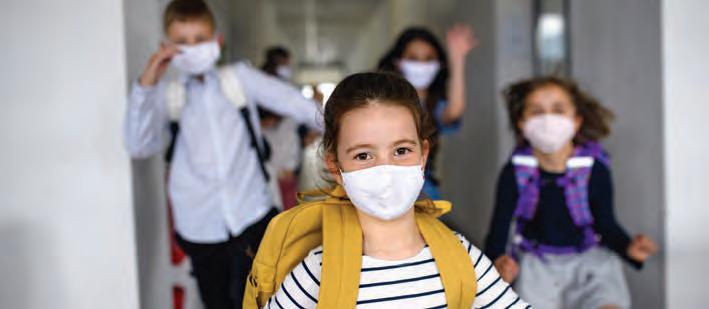
MC: Teachers tend to be flexible and adaptable by nature. No two days in the classroom are ever really the same, so in that sense, I think education as a whole is adapting and handling this very well. But we can’t forget that it didn’t just go from
normal in-class instruction to knowing what was going to be happening and it being online. It was rolled out two weeks at a time, or three weeks, so, as a teacher, the most difficult thing to get my head around, was how long this would be going on. Looking at what was happening around the world, you kind of got the sense that the year was over. But the fact that it was never really said made it difficult, for me anyway.
In terms of getting the students involved, it was a new challenge, but it’s been exciting. It’s been a way to challenge myself to try to learn how to do things in a new way—in a way that makes the kids want to participate. In the classroom, getting participation is a lot easier because they have to be there. They have no choice. And because they’re there, and they’re grade twos, they’re all eager to learn and want to try things out. But remotely, I don’t really know what situation they’re all in at home. Everyone’s got a different home life, so you have to adapt your lessons and your ideas so that everyone can participate.
CB: A teacher like Mitch is doing his best to engage his students and his students are eagerly responding, which is brilliant. But we do have some real disparities with students who may not have access to technology; who may not have access to wi-fi. I know that the local school boards have done quite a bit of work to try and get computers into the hands of students. They’ve turned their parking lots into wi-fi zones. They’ve done all kinds of things to try to help. In some cases, materials are being delivered by mail or dropped off to students’ homes. There are all kinds of strategies going on, but, as Mitch says, it’s been piecemeal because there was no time to prepare.
TM: When you’re dealing with high school level kids who have a bit more autonomy, and who also heard that their marks ultimately wouldn’t be affected by the pandemic, is there more difficulty keeping those kids “in school” for e-learning?
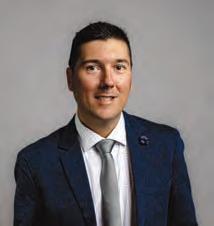
CB: I would say that a motivated student will stay motivated. And those students who are less motivated might not be as engaged.
We did start a free tutoring program at Trent, reaching out to roughly 400 students in the
community. It’s set up as a student work-study program, where teacher candidates are getting paid to tutor over the summer. It not only employs these teacher candidates, but also gives students a one-to-one opportunity to talk with somebody else and to go over their schoolwork together. We’re hoping this offers a motivational strategy.
TM: Many parents have been finding it difficult to juggle working, providing care, and providing rewarding day-today learning experiences. As a parent, how has it been for you?
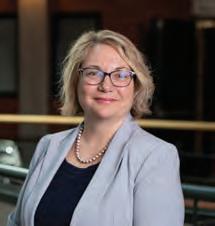
RM: It’s been a learning process for myself, and I have spent a good chunk of my career working from home. My partner and I have been very fortunate that we’ve been able to continue our jobs. Not a lot of people have that opportunity. Going into this, our expectations were high in terms of sticking to schedules and plans. For the first couple weeks, we were adjusting. Then we got into a groove by week three—taking turns squeezing in education in between meetings and deadlines—and the kids were enjoying it. But, by then, we found ourselves getting tired. As a teacher, that’s where I felt guilty. The voice in my head

would be saying that I should be doing a lot more. I had all these resources and access to tools, but it became irrelevant because there was just so much else going on in our lives that we were trying to manage. Eventually those conversations started to turn to the appropriate amount of screen time that we could give our kids. Because, realistically, while we were lucky enough to be working, we did have to work. Sometimes we couldn’t just drop things and do real academic learning with our kids. So we’d come together at lunchtime and in the afternoon, when some of the work demands cleared. We made sure to do academics in the evening.
But the biggest thing we did was just getting outside. Out front, there was sidewalk chalk all over the place. We’d go biking, rollerblading, or just out for walks around the neighbourhood. We don’t really have a routine anymore. We just kind of take advantage of the moments that we have, when we have them.
But there’s a lot of communication between my partner and I. Plenty of encouragement. Reminders that everything is going to be OK; that our kids are young and a lot more resilient
than we are. We’ve gotten to the point where we realize that it’s fine to just play with our kids, get into life skills, and just be with each other, and work on those relationships.
CB: What Rich just said is what I would call the ABC method. A is for Active. Get outside. B is for Balanced. Try and do something independent and have your kids do something independent, and then do something that you enjoy together. C is for Casual. Remember that this is all temporary. We need to stay calm. We need some fun. We need to do what we can without getting overly stressed. There’s a lot of potential for mental health issues during this pandemic, and we need to be very careful about overburdening children and parents. And teachers!
TM: Mitch, teaching from home, your day is obviously different than it was three months ago. How is the worklife balance at your place?
MC: My wife and I have four beautiful kids, so we’ve got a very loud and busy household. My balancing is trying to keep my own kids working while making sure that I’m doing the job I have to do to support the students in my class. Without my wife, Christine, this just wouldn’t be possible. But being a parent is really helping me better understand what I need to be providing for my students. So, I’m using a Google Classroom format, which many teachers are. And I’m posting all my work on Monday morning. The whole week’s work is laid out so that my students have a chance to look at it, to plan, and to make their decisions as to what they want to work on today, tomorrow, or the next day. They’re supposed to be doing about five hours of work a
week, but I’m posting more than that and letting them choose what they want to do. They all have their own situation at home. Some of them have a lot of help from an older sibling or a parent, others are working more independently; so, I’m providing opportunities where students can pick and choose what they’re able to do. While I might post 15 or 20 hours’ worth of work, it’s very wide-ranging, with something for everyone.
I’m seeing my own kids log into Classroom and I’m very appreciative whenever there’s a task that they can just sit down and do. Both my wife and I are teachers and want to spend time helping them, but we have to balance four kids, and our own needs.
So, we’re taking pretty much the same approach that Rich is, and that Cathy alluded to. We’re trying to find a balance every day and throughout the week. We’re trying to make sure our kids are happy and engaged. And moving forward from there.
TM: What techniques do you use to keep your students engaged from a distance?

MC: I just want to mention the importance of trying to maintain community. Because our students are missing their friends. They’re missing their peers and classmates and their teachers. So I’ve been really trying to focus on ways to build community. While the Ministry of Education has told us that we should be focusing on literacy and numeracy, I’m trying to add in other sorts of things that are going to engage students and make them want to contribute and be part of the classroom.
One thing that’s been pretty successful: I’ve created a Google slideshow that’s open to anyone in my school and I’m calling it the Weekly Lego Challenge. On Mondays, I’ll announce the challenge, to build an amazing animal or a rocket ship or a dream home. I’m having all the teachers at my school post it in their own classrooms and make that same slideshow available. Students have that week to get creative, build something, post it to the slideshow, add their first name and their grade, and have other students from other classrooms get to see their work, leave comments, and re-create that sense of school community that we had at our physical school.
At my school, we do things as a school. We have dance parties. We do yoga. We practice for cross country as a school. All kinds of great things. And I’m trying to find ways to keep that going.
CB: I’ll add another layer, and that’s around wellness checks: taking an opportunity to really ask the students how they’re doing. To connect and check in on them. It makes a huge difference. The students want to be in that community. They want to hear each other. They want to have a chance to chat. They want to see their teacher. As a teacher, it’s sometimes about showing that you care about them, and teachers do care about their students so much. And the students really appreciate those moments
TM: What have you been doing to keep your kids engaged in the educational process?
MC: I’m going to let you in on a little secret here: It’s easier if you have a whole bunch of kids. If you have one, it’s all on you. You’re the entertainment. With four kids, I really try to leverage the resources I have in my house. So the older siblings teach the younger siblings. Whenever my youngest, my senior kindergarten, has some homework to do, he’s
doing it with his older brother or one of his older sisters. And likewise for everybody else.

It’s a good strategy, because we learn best by teaching. You learn a little bit by reading or watching. You learn a little bit more by doing. But when you can get to the point where you’re actually showing someone else how to do something, you’re learning in a much deeper way than you ever could otherwise.
CB: When kids are outside and they’re playing, or whatever they’re doing, they are learning. There is school learning, and there’s life learning, and sometimes those intersect really well. But what is available to kids right now is a whole world of backyards, with all kinds of learning opportunities, including family time and alone time, and being resourceful on your own when your parents can’t help you. Those are all rally important parts of the bigger picture of learning.
TM: How, as educators, do you prepare for situations like this?
MC: I think staying on top of trends in education is an important first step. While there is a large population of teachers that were starting to transition to online teaching for the first time, or had only dipped a toe in, I was already pretty well immersed. Even with my grade two students, it was pretty easy to pivot to a different platform. What’s important is having an open mind and not expecting things to work out perfectly the first time, or maybe even the fourth time. We need to be adaptable and not be too hard on ourselves when things don’t go well. And we need to remember that everyone is learning. I think putting that stance forward in your classroom with your students, whether it’s in front of them or virtually, makes making mistakes OK. It also gives your students the confidence to try something new without the fear of failure.
TM: What does the School of Education do to prepare teaching candidates for situations like this?

CB: Part of it is remembering that the fundamental qualities of a good teacher are the fundamental qualities of a good teacher, whether they’re working in the remote environment or in person. Listening to Rich and Mitch, the skills they have are evident. It doesn’t matter if it’s in person or online, they’re going to be amazing teachers. So there’s that piece. We always want to focus on those fundamental skills of being an engaging, knowledgeable thoughtful, inquiry-based teacher.
But on top of that, there are some real technical types of issues emerging. For example, what happens in the fall if the schools close again and our teacher candidates need to have placements? What does that look like? One idea is that we could help prepare the teacher candidates to know how to run literature circles,
so they can meet with five students at a time with a very specific piece of reading, or novel, or whatever it may be, and guide them through thinking about that text, and reading and sharing the love of that text, together. Or the teacher candidate could lead a small group on solving math problems, and work with that small group to guide and support them in that inquiry. There are some really interesting possibilities. But it does change the way we think about priorities. In a remote environment, one of the most important things is engagement. Not so much classroom management, but more about how we are interacting with students on a one-to-one basis, in small groups, and so on. So far, it’s been a really engaging conversation. I’m looking forward to seeing the innovations that our faculty generate through this process.
TM: The School of Education recently celebrated their 15th anniversary. Tell me a little bit about the significance of that,
CB: As the dean, I can say this very proudly: we have an incredibly popular and successful program. We have a very strong program. Many students want to come to Trent to do their education degree because of the reputation of our faculty, the small class sizes, and our focus on social justice, on Indigenous education, and on supporting learners with special needs. Those kind of core pieces to our work have made us stand out. I’m so proud of being the dean at Trent in the School of Education, and I’m honoured to work with the faculty here, and our teacher candidates, who are exceptional. Our Teacher Education Stream and our master’s programs, too. It’s just a joy every day.
During the height of the provincial shutdown, earlier this spring, TRENT Magazine/The Trent Voices (TM) podcast sat down for a virtual interview with two Trent/ Fleming School of Nursing alumni to talk about what it was like to be on the COVID-19 front lines. Nurses Scott Wight ’11 (SW) and Natalie Beavis ’96 (NB) were joined by School of Nursing dean Dr. Kirsten Woodend (KW) for a unique glimpse into pandemic life in the healthcare sector.
TM: Health care workers everywhere are experiencing unique challenges. What does the COVID experience look like at your institution?

SW: I could probably echo a lot of sentiments with hospitals in Ontario, across Canada and around the world. It’s tense in the sense that we’re always
in a preparatory and waiting stage for the next challenge we’re having to face. When COVID was first on its way, we were lucky that Canada hadn’t had too many cases. We were able to prepare and try to foresee what the challenges would be. I was fortunate to be involved with a lot of preparatory meetings, outlining what we’d need; what kind of assessment centres we would need; how we would respond to an influx of COVID patients, and so on. That preparation has led to a good foundation at our hospital.
Our staff are worried because the stocks of personal protective equipment (PPE) are low. They’re always waiting to see when the next dry spell of face masks and face shields or gowns will be. So that’s a worry. And we’re worried about how to support when long-term care facilities have 10 patients that need hospitalization—and what we’re going
to have to do for them, and how we’ll have to support them. I think other hospitals have had it worse than us. I know that other communities have had it worse, so we’re very lucky. But we’re really trying to prepare for what the worst might be, and always in that state of readiness.
NB: I think that morale is strong. The one thing that really jumps out at me in terms of the themes is this whole notion of teamwork. I’ve seen individuals from all walks of the healthcare system work so well together with the common goal of keeping the community safe, patients safe, and caring for one another. I would say that, here, our PPE situation is quite good. We’ve had an immense outpouring from the community. The community has taken such great care of us and our healthcare workers
through large drives around everything from masks to caps to bands for securing surgical masks. The information I’m getting from our nursing staff is about feeling appreciated by the community.
I’m proud of the hospital because of what we’ve been able to exhibit: at the frontline, in the community (in our partnership with Public Health), and in our new partnership with long-term care. This notion of partnership has been strong and I couldn’t be prouder to be a nurse.
TM: Dr. Woodend, you’re not working in the hospital but you’re also not working at Trent right now. With the University shifting to remote operations, what are the working conditions like for you?
KW: It’s been odd. But I find it interesting that we talk about social isolation, because, in fact, we’re not very isolated. And thanks to venues like Zoom, I’m in meetings with colleagues and students five to seven times every day.
As you can imagine, in the winter semester our students’ placements (clinical education) had to be stopped because we couldn’t send them out into clinical after about mid-March. So we’ve had to struggle to find alternate ways to help them meet their learning outcomes, and to try to keep as many students on track as possible. I work with an amazing set of nurses at the School of Nursing, and there wasn’t one complaint as everybody reached out and worked extra hours to figure out how to meet our students’ learning needs so that we were continuing to graduate strong nurses who were well prepared to work in any environment. And the environment right now is very chaotic.
TM: How are nurses (and doctors and hospital staff) feeling during this crisis?
Is the tension felt throughout society prevalent?
NB: I think that, very often, we’re at our best when we’re most necessary; and so that preparation that Scott has talked about has provided us with a really good jumping-off point for absolutely anything that’s required.
Just today, I had the wonderful opportunity of being able to go out and say thank you to our nurses in person, and what I saw were hardworking men and women devoted to patient care and really focused. That filled me with a lot of confidence. The morale, from my perspective, is really solid. I think that we’re all in the same place around patient care, and it’s a collective concept and idea that all nurses can really get behind. It’s something that we see from our Trent graduates. I had an opportunity to meet lots of new grads today because they’re out on our units working really, really hard. And we all have a sense of contributing to really good work together.
TM: How does it feel to be a frontline worker right now? Your chances of coming in contact with the virus is higher than with most people. How does it feel when you’re leaving work for the day and going home?

NB: We’ve been fortunate to have a lot of information about infection control. So, for myself, for my staff, and for all of the nurses here at the hospital, proper infection control practices are central. Our department has been responsible for providing PPE education, alongside Infection
Prevention and Control (IPAC). Donning and doffing, for example, are very important when it comes to infection control. We’ve worked really hard to be able to share our lessons within the hospital, as well as with our partners in long-term care, for example. With that in mind, I do have a sense of confidence. But it’s evolved over time, because we started COVID in one place and we’re now in another. At this stage, when I go home, I feel safe and secure. I have a really supportive family. They’re proud of my work as a nurse. And I have a really supportive community that’s really proud of my role as a nurse. All of that feels great.
SW: I have my mother, who’s 70 and living at home with us, so there’s a bit of added responsibility. We’ve got two kids. I’m quite cognizant of what I’m touching at the hospital and who I am interacting with. Our hospital staff have been really great at supporting everyone, so I can work at home, which has been good. Unfortunately, I’ve also had to go in a lot, but there’s that understanding. As Natalie indicated, the education is really important. Understanding how we doff and don; enabling good practices. In the past, some people may have been complacent, but now, certainly, everybody everywhere can see the importance of these practices. And having specialized teaching towards COVID has been really, really important.
To be honest, it’s more of an underlying thought. I know that it’s always there. But my number one priority is supporting clinicians and nursing staff and ensuring safety and best practices.
SAleksa MoonriseTM: Dr. Woodend, how do you help prepare prospective nurses so that they’re emotionally ready for situations like this—not just at work, but with the work/home balance as well?

KW: We start in their first year by talking about the profession of nursing. There is actually a first-year, first-semester course where they are introduced to things like mindfulness, so that, right from the start, they have a more inner awareness of their responses to things. It’s quite interesting: we had conversations with the group from Peterborough Regional Health Centre last week in a focus group, and we’ve had meetings with other groups, and one of the things that we’re hearing is the importance of resilience. We do try to build resiliency into their experience: when they do practice on the units and they debrief with their teachers afterwards; or when they’re doing a simulated learning scenario and there’s a debriefing. The capacity to reflect on what you’ve done is important. And to think about alternative ways of doing things. And learning to share with your colleagues, because that’s part of resilience too.
I must say, I’m thrilled to hear from Natalie that she’s been out there working with some of our new grads and that one of the things that she is observing is resilience.
I think, given that within the last approximately 20 years we’ve now had three outbreaks of a coronavirus, that this is our future. We are going to need to graduate nurses who are very resilient, so we’ll continue to look at how we do that.
TM: What advice do you give to patients who are concerned about COVID-19 and trying to stay safe?
SW: Hospitals have procedures, and they have ways of doing things. Look at those standards. Wear a mask. Try to be proactive. I know, for myself, I try and be that person who hopefully people look to. And so I make sure that I go out with a mask and I actually take my little safety glasses too. And don’t touch your face. Try to stay away from people. As difficult as it is, socially isolate as best as you can without having to lose social interaction and care.
TM: Dr. Woodend, you do have a background in epidemiology. How concerned should people be about COVID-19? And what they can do to make themselves feel at least a little bit better in their day-to-day lives?
KW: We need to continue to adjust to this new normal without letting it dominate our thinking.
We’re very blessed in Canada, when you look around at, for instance, the disagreements in the UK or in the US, where multiple voices are influencing decisions that are made.
quarters of the way through their trip, start to go through mood changes, and have struggles with mood. I think we’re in that stage now. We’re seeing the plateau and so we’re now thinking that a normal, or new normal, could be coming and we’re impatient for it. This may be a time, in fact, when we’re starting to have more struggles with mood. So, I think we need to make sure that we take better care of ourselves and reach out for support systems. Make contacts in all the ways that are now possible.
TM: How did your Trent experience help inform the work you do today?
NB: I think that the most unique aspect of my Trent experience was the ability to blend nursing science with the humanities. It allowed me to be someone who is a strong scientist and a strong caregiver at the same time. That has informed my entire nursing career. It’s given me an opportunity to be a well-rounded individual who’s also been able to engage in different components of nursing—which includes bedside work, academic work, decisionmaking work, leadership work. The
perspective, an individual who’s been really interested in seeing my nursing self from various different vantage points. And it’s made for a wonderful career that I’m very proud of.
SW: I think one of the things that has really stuck with me, and certainly has been immersed into my practice, is the ability to be a role model and to be a collaborative resource—to be that person who can help, and work towards getting a problem solved or creating something amazing. I don’t think people realize the amount of background nurses need to have in terms of understanding: how you treat patients, how you treat your colleagues, and how you interact with people.
There are a lot of social skills involved in being a nurse. You need to be able to communicate with people. And I really benefitted from an opportunity to work with leaders and professors at Trent who really embraced that. They took that holistic perspective to the next level.
TrentUniversity School of Nursing alumna Tsering Bharwani ’11—along with her husband, Saroop Bharwani—has started a program to help make life easier for frontline health workers and Liberty Village (Toronto) businesses. SensoGo has raised over $60,000 to supply locally sourced meals and gift packages for hospital staff, positively impacting the lives of over 1,500 workers. The money raised has been funnelled back into their community, with food and other products being purchased from local companies that have taken an economic hit from the pandemic.
Ms. Bharwani, who returned to her nursing position from maternity leave as the COVID crisis was first starting in Toronto, made the difficult decision to isolate herself from her family, spending months at home while her husband and daughter stayed with extended family. That experience was part of what influenced the couple to start SensoGo.
“I was one of thousands of healthcare workers who had made the sacrifice,” she explains. “I wanted to make sure they were all honoured and that the world knew about them.”

One SensoGo program, Front Line Moms, saw $25,000 worth of products delivered to 500 workers in carefully designed care packages. Ms. Bharwani was hands-on in choosing products and physically putting packages together.
“We went with things that were really useful,” she notes. “For example, there were many frontline workers who experienced skin problems from wearing masks for extended periods, so there were skin care products included that helped with that.”
SensoGo started small and grew organically. Inspired by a friend who had sent pizza to a floor of workers at a hospital, Mr. Bharwani did the same for Ms. Bharwani and her colleagues. Soon others were joining in. As CEO of Senso, a technology start-up, Mr. Bharwani reached out to partners in the tech sector. The couple soon had a website and started seeking sponsors in earnest.
They chose to work with business in their Liberty Village neighbourhood that were hit hard by the pandemic. Money raised was used to purchase either meals or contents of care packages for frontline workers.
Front Line for Black Lives
When the Black Lives Matter protests began, the pair realized they could also use their platform to show their support. They enlisted Mr. Bharwani’s cousin, Sheena Melwani, to perform a song and then made a video with contributing frontline workers— including several Trent School of Nursing alumni.


“When I approached my frontline friends, they were excited and jumped on board,” Ms. Bharwani recalls.
“They are very passionate about this.” Healthcare and Black Lives Matter definitely intersect, she says. “Look at the stats. There are some alarming stats about Black maternal health, how Black mothers are three to four times more likely to die during pregnancy, or before or after delivery. Black people have higher risk of chronic diseases. Studying nursing, I learned about the social determinants of health, where you were born, where you live, the type of education you received, your employment opportunities, and how all of this impacts your health.”
She also recognizes clinician bias as an issue. “The bias that we healthcare workers carry—consciously or unconsciously—can impact your interaction with patients, your delivery
of care, the amount of time you spend with someone, even being dismissive of symptoms. All these things contribute to the poor health outcomes that Black people are going through right now.”
Ms. Bharwani recognizes the change that can be made by her and her colleagues. “There are things you can do as a frontline worker, rather than passing it off as a systemic issue and leaving it at that. There are things that are in your control. You have the power to change that treatment, change the experience of a patient. As front liners in this video, we’re
almost taking an oath to do that. We’re going to recognize this bias and dismantle it. When we see this kind of thing happening, we need to speak up. We have the power to change the narrative.”
Much of her passion for making positive change came from her time being part of a community at Trent. “I was pleasantly surprised by the diversity of Trent, how multicultural it was, and how that was celebrated. There was always a sense of belonging.”
Help shape the future of Trent as we update the Trent Lands & Nature Areas Plan
The Trent Lands and Nature Areas Plan will assist the University to achieve its vision of a ‘sustainable and inspiring campus community, thoughtfully integrating the natural and built environment with vibrant spaces to learn, innovate, be active and live.’
Visit trentlands.ca during the month of October to review the draft Nature Areas Stewardship Plan, the draft Framework Flan, and Guiding Principles. Share your comments and thoughts on the draft documents. Help us finalize the Trent Lands and Nature Areas Plan and shape the future of the Symons Campus.

STUDYING RURAL AGING AT TRENT UNIVERSITY

Trent Centre for Aging & Society’s new director brings her love for rural, communitybased aging research to the classroom and beyond
Community connections are what bring Dr. Elizabeth McCrillis’s research and teaching to life. Early in her academic career as a psychology student at Memorial University of Newfoundland, Dr. McCrillis felt pulled beyond the walls of classrooms and labs to work closely with local individuals and organizations to explore health challenges facing rural communities. As a graduate research assistant, she found herself driving along rural roads in Newfoundland and Labrador, interviewing caregivers and older adults about their experiences with the long-term care system.
“As a young person, travelling to remote communities and interacting with older people inspired a complete switch to studying aging at the Ph.D. level. I had a goal of connecting with older people who were often marginalized from mainstream research, given the logistical and geographic challenges inherent to applied rural research.”
During a brief hiatus from her Ph.D., Dr. McCrillis worked with the provincial government in Newfoundland and Labrador’s Department of Municipal Affairs. As a program and policy development specialist, she met regularly with agencies and departments that supported and worked with older adults, and ultimately was approached to evaluate the AgeFriendly Newfoundland and Labrador Grants Program for her dissertation. Using a community-based research approach, joining together academic and community expertise in order to comprehensively understand local challenges, her doctoral work involved travelling to numerous
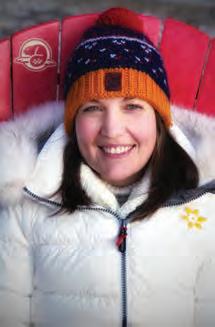
communities across the island of Newfoundland, connecting with community stakeholders working to make their communities more inclusive of and supportive to their aging populations. Ultimately, her research uncovered a new way of understanding the implementation of age-friendly community change in rural communities.
“I’m always so excited to get involved with local organizations and to meet with community members. These types of projects often involve a lot of groundwork and can be challenging to run, but the benefits are significant—it means my research can make a positive impact.”
Thoroughly at home in Newfoundland and Labrador, it was a position at Trent University’s Psychology Department that brought her to Peterborough, and back to her home province of Ontario, in 2016.
“Newfoundland and Labrador is an amazing place. It’s beautiful, rugged, rural, and remote. It’s an adventure to live and be there and I never thought I would leave.”
At Trent, Dr. McCrillis teaches courses in the psychology of aging, qualitative research methods, the history of psychology, and health psychology, always highlighting community-based research as part of her effort to apply class content outside of the university setting. “It’s important to have a solid foundation in theory, but I also want my students to see how psychology can and does have an impact in the real world.” She also notes how community-based research and learning from others can provide essential context, regardless of the topic. “You have to get outside of the walls of an institution to try and understand, for example, where do women fit in to the history of psychology? What about other marginalized people? Why don’t we talk about them? I dig for those factors and share them in my courses, encouraging students to take that questioning with them wherever they go.”
Of special significance to Dr. McCrillis is a third year Psychology of Aging course. She was struck by the number of times she heard students remark that their own ageism or fears of aging declined after taking the course. With ageism being so prevalent in our society—it has been referred to as “the most tolerated form of social discrimination in Canada” by a Revera Inc. study—it wasn’t uncommon for students to enter the course with negative beliefs or fears about what it means to grow older. Inspired to further explore this potentially positive impact of the
course on students, Dr. McCrillis launched a longitudinal study, along with colleague Dr. Éric Thériault at Cape Breton University, titled Beyond Pedagogy: The Impacts of a Psychology of Aging Course on Undergraduate Students’ Perceptions of Older Adults and Old Age, together collecting two years’ worth of qualitative and quantitative data from students taking their psychology of aging courses. The similarities between Cape Breton University and Trent University—both smaller, undergraduate-focused universities located in smaller cities surrounded by large rural areas characterized by rapidly aging populations—helped strengthen the data. During focus groups and interviews, the research team consistently heard students say things like “I don’t fear aging anymore,” or “I understand the perspectives of older people now,” or even “I’m actually looking forward to getting older.”
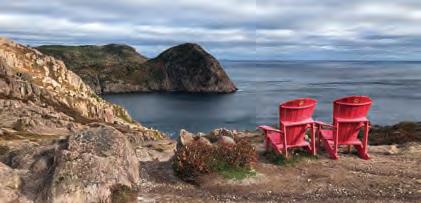
“Many students frankly reflected upon their own ageism before taking the course, or observed that they feared speaking out against ageism without an understanding of the science that debunks those myths. They often reported no longer holding ageist beliefs, or that they are ready to identify and stand up against ageist practices and comments— with some even considering careers working with older adults,” remarked Dr. McCrillis.
The findings will be published later this year, but the project doesn’t have to end there. Dr. McCrillis hopes to expand this to a national study, testing the research findings at other Canadian universities. She notes that courses like Psychology of Aging aren’t offered at many universities, but because of our growing aging population, it is a socially relevant topic worthy of incorporation within relevant undergraduate curriculums. On the topic of aging studies courses and research offerings, Trent University is a leader.
The Beyond Pedagogy study is one of Dr. McCrillis’s three research streams. She also works closely with Dr. Mark Skinner, Canada research chair in Rural Aging, Health and Social Care and founding director of the Trent Centre for Aging & Society (TCAS), and research coordinator Amber Colibaba on their Building Age-Friendly Communities Collaboration—a variety of projects that examine rural age-friendly initiatives and the factors that help, or hinder, their sustainability, along with other aging studies topics specific to the rural experience.
In response to the COVID-19 pandemic, the team has just embarked on a new project, exploring the experiences of older volunteers and volunteer-based programs in Selwyn Township during the pandemic. Studying the impacts of physical distancing
on older volunteers, the team is drawing from case examples of voluntary organizations working within the fields of seniors’ housing, rural volunteer firefighting, and a volunteer-led library. Within this, they are examining the uniquely rural challenges of older volunteers supporting older people living in rural communities, in an era of global pandemic. The team is recruiting local volunteers from Selwyn Township to participate in their community-based research.
It was actually Dr. Skinner who invited Dr. McCrillis to join TCAS as a member when she first arrived at Trent in 2016. Within two years, Dr. McCrillis became an executive member, playing a pivotal role in fostering connections between students, faculty, visiting scholars, and the public. She is honoured to lead the Centre into the next three years as director.
“The Trent Centre for Aging & Society is a special place comprised of wonderful people, working toward important goals and action related to growing older in our communities,” says Dr. McCrillis. “Going forward, I aim to carry forward this vision of collaborative, community-based work in aging studies here in the Peterborough area and beyond.”

THANK YOU FOR MAKING A DIFFERENCE

Your loyal generosity helps remove barriers for Trent students to empower them to make significant contributions to an increasingly complex world. You do this by creating vibrant, engaged, and sustainable communities of learning, teaching, and research, and for this, we are truly grateful.

It was an exceptional year in so many ways. Through the unprecedented challenges of physical isolation and distance learning, the Trent family came together to support its students and community. More than 1,200 students who faced challenges, financial and otherwise, during this pandemic received support. With financial need expected to increase over the coming months, we are continuing to fundraise to ensure that changes to a student’s financial situation never become a barrier to access a Trent education.
Through your philanthropy, Trent has been able to fund a brand-new residence building and academic space at our Durham campus, strengthened support for Indigenous students, brought world-class thinkers to campus to inspire students, and built endowments dedicated to college life.
As the world grapples with the health, economic and societal impacts of the COVID-19 pandemic, the role of universities has never been more critical. Both current and graduating students need to be equipped to advance the research and infrastructure needed to combat this and future pandemics. Moreover, every student, through a Trent education, can exercise the creativity and resilience to overcome obstacles and find their place in the world—a place where they can make a difference. Your support has been integral to helping students to reach their full potential and engage with the world around them as active, thoughtful individuals.
By working together, we will continue to be an institution that challenges the way we think about the world, offering a personal, purposeful, and interactive education. And we are determined to emerge stronger, more resilient and better prepared, as we fight against COVID-19 and restart the economy.
Sincerely, Julie Davis Vice-President, External Relations & Advancement#TRENTUCARES CAMPAIGN SUPPORTS STUDENTS DURING COVID-19



The #TrentUCares Campaign supports Trent students affected by COVID-19, and through the Student Rapid Relief Fund (SRRF), $113,000 of emergency support has been distributed directly to students. With financial need expected to increase over the coming months, Trent University is continuing to fundraise for student relief support, which will aim to ensure that changes to a student’s financial situation do not become a barrier to access a Trent education.
A portion of funding for the SRRF came from Trent’s five colleges, the Trent University Alumni Association, the Trent University Faculty Association (TUFA) and the Ontario Public Service Employees Union (OPSEU).
The new fund, established specifically to assist Trent students experiencing financial hardships due to COVID-19, complements Trent’s reputation as a national leader for scholarships and bursaries and builds on additional emergency funding provided by the University.
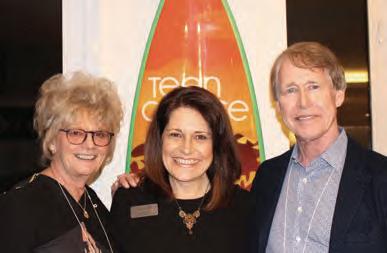
GROWING TRENT DURHAM GTA
Doors opened
It is a tremendous time of growth at the Trent Durham GTA campus. The Campaign is helping to make the vision of an exciting future into reality by supporting a campus expansion project, increasing financial aid for students, and providing more career-enhancing experiences to ensure the success of Trent graduates.
• A bright, contemporary six-story building provides the campus’ first-ever residence with academic space. It provides new spaces and enhanced opportunities for the entire Trent Durham GTA community to learn, study, socialize, and engage in life on campus


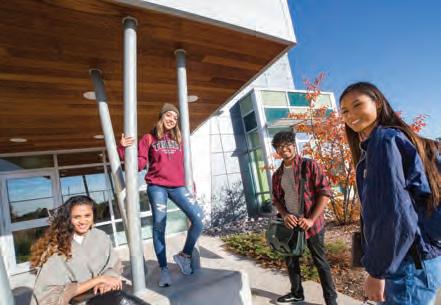
• Katie Taylor, the first woman to chair the board of a major Canadian bank, and one of Canada’s most influential and powerful citizens, has joined the Campaign for Trent Durham as its honorary chair
• The Region of Durham gifts $1.42 million to help expand Trent University Durham GTA

• The city of Oshawa donated 1.8 acres of land to enable the Trent Durham GTA expansion
• The Trent University Faculty Association supported the Campaign with a $25,000 matching donation
• Trent Durham staff and faculty came together and supported students, raising over $56,000 through the Together, We’re Trent Durham Staff & Faculty Campaign
• Local business leaders Edmond and Sylvia Vanhaverbeke invested $135,500, supporting the new residence and academic building, and students through the Edmond & Sylvia Vanhaverbeke Durham Scholarship and Bursaries
• Trent alumna Beth E. Kelly ’83 provided a meaningful gift to support the new residence and academic building and students through the Beth Kelly ’83 and Family Student Prizes
2020 trentu.ca/givetrentdurham
•
•
•
“ It is very important that the experience I had at Trent, which I valued very deeply, be made available in this larger context of the Durham region and GTA.”
Doug Kirk ’70, Campaign for Durham GTA Co-Chair
Board of Governors’ Leadership Scholarship Attracts Top Student
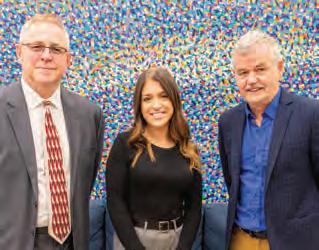
First-year student Maggie Drover is this year’s Board of Governors’ Leadership Scholarship recipient. By the age of 18, Maggie had launched a charity, run her own business, represented the Labrador City Recreation Commission, and fundraised for Heart and Stroke, Epilepsy and Red Shield.
Estate Gift Supports Bold New Forensics Crime Scene Facility
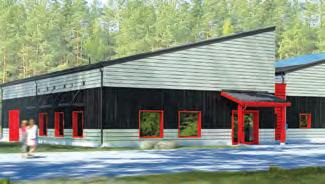
A brand new Forensics Crime Scene Facility at Trent University will set new academic and environmental standards all at once: as a first-of-its-kind professional forensics training building constructed on a Canadian university campus; and with a goal to be Canada’s first zero-carbon building certified by the International Living Future Institute. The project was made possible by the legacy gift from former Board of Governors chair, the late Jalynn Bennett.
Empowering Teaching and Removing Barriers
Alumna Karen Wickerson ’87 gave back to Trent by creating faculty grants for universal design strategies. Through the Wickerson Foundation Fund, Trent’s Centre for Teaching and Learning and Student Accessibility Services provides two faculty with grants to design and implement course-based
strategies that support diverse student learning needs and addresses barriers to learning.
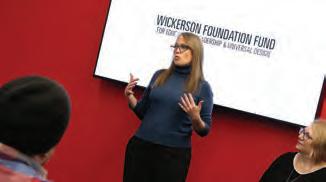
RALLYING FOR TRENT COLLEGES
Trent’s history as a collegiate university is part of what makes us unique and successful, and Trent continues to embrace the importance of colleges as smaller communities within the broader university. Over $1M has been raised to establish college endowments. Through The Campaign for Trent Colleges, each college aims to raise $1 million to build endowments dedicated to College life.
Alan Harman ’80, Chris Fountain ’94, Greg Piasetzki ’76, Martha Wilder ’74, and François Senécal ’83 have stepped forward to champion The Campaign for Trent Colleges Banding together
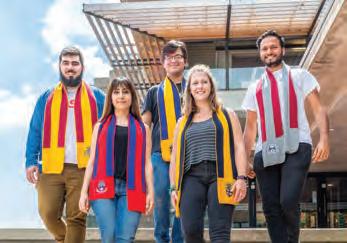
talent,
that
experience
their college spirit, they
treasure
cherished
investing
ensure that the college
a strong part of the
students.
THOMAS MILLER ’82
EMERGENCY PHYSICIAN TRENT VARSITY ROWER PRESIDENT, PRC COLLEGE CABINET ADVOCATE, HEALTH AND HUMAN RIGHTS MT. VENTOUX CYCLIST
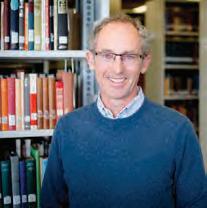


Remembering Trent in his Will, Tom’s legacy will ensure the vibrant, residential, academic, college-based education he is grateful for remains central to Trent.
Rachel Smylie, fourth-year International Development student.
Trent and Traill College shaped me in many ways— from the academic subjects I studied, to the friends I made and the non-academic interests and hobbies I acquired during those years. I believe we should all give back, when the opportunity presents itself.”
What will your legacy be?
Greg Piasetzki ’72
Spurred on by the spirit of the Campaign, Dr. Tom Miller ’82 and Barbara Chisholm have made a meaningful $100,000 gift to support student clubs at the former Peter Robinson College through the Richard Sadleir Peter Robinson College Fund.
trentu.ca/legacy
“ My college experience moulded me into the Trentspirited human that I am today.”
“
NEW RESOURCES SUPPORT LEARNING & RECONCILIATION ON CAMPUS
Trent University has unveiled several initiatives to support staff, faculty and students in learning about the treaty and traditional territory on which Trent is located, while building stronger, mutually beneficial relationships with local Michi Saagiig (Mississauga) Anishnaabeg communities. These initiatives have been made possible by the legacy gift from former Board of Governors chair, the late Jalynn Bennett. The Jalynn H. Bennett Foundation donated the largest legacy gift in the University’s history.
• Two honorific namings have been granted by the Elders & Traditional Knowledge Keepers Council. The traditional area, with a medicine garden, tipi and wigwam, has been named Mnidoowag A’Kiing, or the Spirit Lands, to honour the spirits called the land during ceremony. The Indigenous Learning Space in the Bata Library was named Giizhigaatig, or Cedar Room, honouring the importance of cedar as one of the sacred medicines of the Anishnaabeg.
• The Protocol Handbook was created to learn about the Mississauga Anishnaabeg, their history, traditions and cultural protocols.
• Video Supports: To encourage the Trent community to participate in smudging and to more fully understand the significance of the land acknowledgement, instructional videos were created under the guidance of Elder Dr. Keith Knott of Curve Lake First Nation.
To learn more about creating your own legacy: trentu.ca/legacy
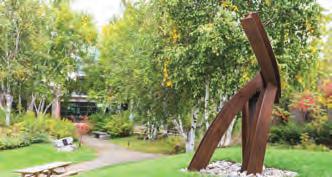
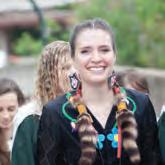
BRINGING ART TO CAMPUS
Claude Millette’s sculpture is the fifth piece unveiled as part of Trent’s Public Sculpture Initiative. Trent’s public sculpture initiative celebrates sculpture in Canada and will help the University continue to acquire nationally significant works that present unique and diverse artistic practices. As the initiative continues, artists are invited to add their work to Trent’s collection of more than 600 works, blending natural and human creations for all to enjoy on Trent’s beautiful campuses.
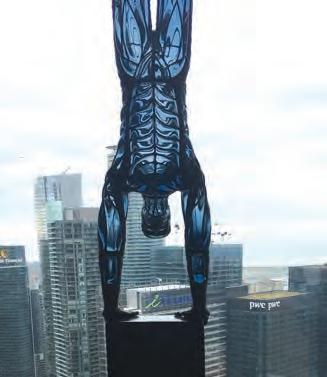
Memorial gifts create lasting legacies
Memorial gifts honour & celebrate the legacy of our exceptional faculty
• Dr. Bruce W. Hodgins
• Dr. Daniel Powell
• Mrs. Karen & Dr. Peter Barrett
• Dr. David Ellis
295 LEGACY SOCIETY MEMBERS
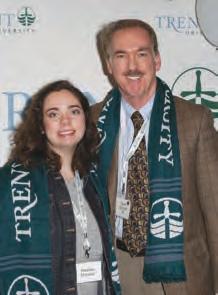
Your Generous Support Makes Trent Stories Possible
My focus is on finding ways to help people who slip through the cracks of programs that are in place—to help people struggling to survive. I would like to get my Ph.D. and to design programs that could change the ones already in place, or replace them altogether, in order to help those who are not getting the help they need. Thank you for helping students like myself. It’s through support like yours that really helps us students get through each year.

Trent University means a great deal to my family, as my father-in-law was one of the university’s first employees. Jack Smith was employed as a supervisor of Mechanical Operations until 1979 and was instrumental in the building of most of the main campus. My family is very grateful to be back home in Peterborough and expresses our thanks for the Bagnani scholarship.
Teaching has been a dream of mine since I was a little girl. I am very passionate about working with students and seeing them grow and prosper as individuals, in a positive environment which I can create. With your generous help, I am now closer to being able to do so.
I have always excelled in school, despite being a first generation student. No one in my family has ever attended post-secondary, mostly due to financial restrictions, so this really means a lot. I have wanted to go into nursing for a long time and you are assisting me with my goals in life. I cannot thank you enough.
At Trent, I have been able to prove my capabilities, demonstrate that the faith placed in me by family and professors was wisely given, and, most importantly, help guide other students who are in need of a push. Just as others did for me. Your generous donations have made this possible. I cannot express how this grant has opened possibilities and changed my life, but I hope to thank you, sincerely, for providing it. I also aim to take the spirit of charity that you have shown and apply it to the students I teach now and in the future.
“ The Greatest Need Award demonstrates that there are people out there that go beyond listening to the need for financial aid by becoming part of the solution. These last few years have been truly tough, but I look forward to one day finding myself on solid ground where I can be on the giving end of these donations. Your generosity has brought me one step closer to my goals and I am very grateful for your part in my continuing education.
“
Natasha Randell-Tremblett, Alumni Bursary recipient
“
“
Daijauna Falkin, Board of Governors’ Leadership Award recipient
“
“
Read more about Mary Jane’s story and how giving to the Trent Fund impacts the student experience. Visit trentu.ca/trentfund to make a donation today.
STUDENTS 2020
The Future is Now
Meet Mary Jane Dovres, a fourth year Honours Biology student, passionate outdoor enthusiast and recent recipient of donor supported bursaries.

THE FUTURE IS NOW
IN MEMORIAM
Emily Allemang, retiree Christopher Baker ’81
Maureen Boldt ’78 Gary A. Bower ’87 David W. Brooks ’69 Ishwar C. Chakravartty, professor emeritus
Ronald C. Clark ’67 David Ellis, faculty Shelagh D. Grant ’76
William J. Green ’73
Marla J. Hayes ’72
William Hodgson, retiree Sean T. Hudson ’17
Wayne R. Kay ’68 Jeffrey Lapalme ’11
Anthony Lieb ’73 Amy L. Lynch ’82 Lynn L. MacAulay ’87
Linda Matthews, retiree John E. McCartney ’65 Sheilagh M. Monette ’89 Cindy Ellen Morgan ’75
Deb Nichols, retiree Yvonne O’Reilly, staff
Timothy Porteous, hon. alumnus
Neil P. Rose ’81 Margaret R. Sanders ’72 Sybil Stairs ’70 Martyn R. Thomas ’65
YOUR NEW ALUMNI WEBSITE
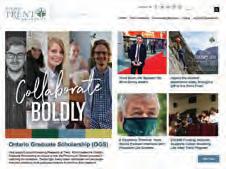
We’ve streamlined and transformed our web pages in order to put everything that you need under one roof, including: benefits, services, communications preferences, email, tax forms, transcripts, philanthropy, news, podcasts, TRENT Magazine, and much more!
www.trentu.ca/alumni
Alumna Leslie Lewis (née Shuter) ’66 recently shared some wonderful snapshots from her time at Trent, including gowned students getting on the bus at Traill College and a horse drawn sidewalk plow—which will definitely come as a surprise to younger alumni.
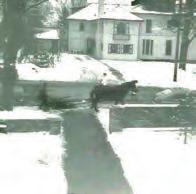
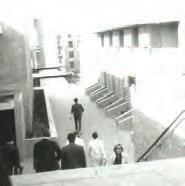
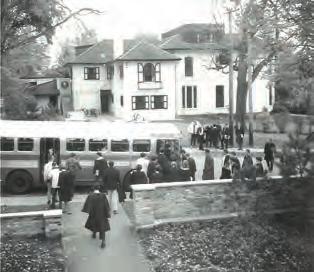
Lewis studied English and Psychology from 1966 to 1969. Do you have any photos from the past? We’d love to share them in TRENT Magazine and on our social media. Message donaldgfraser@trentu.ca to share.

